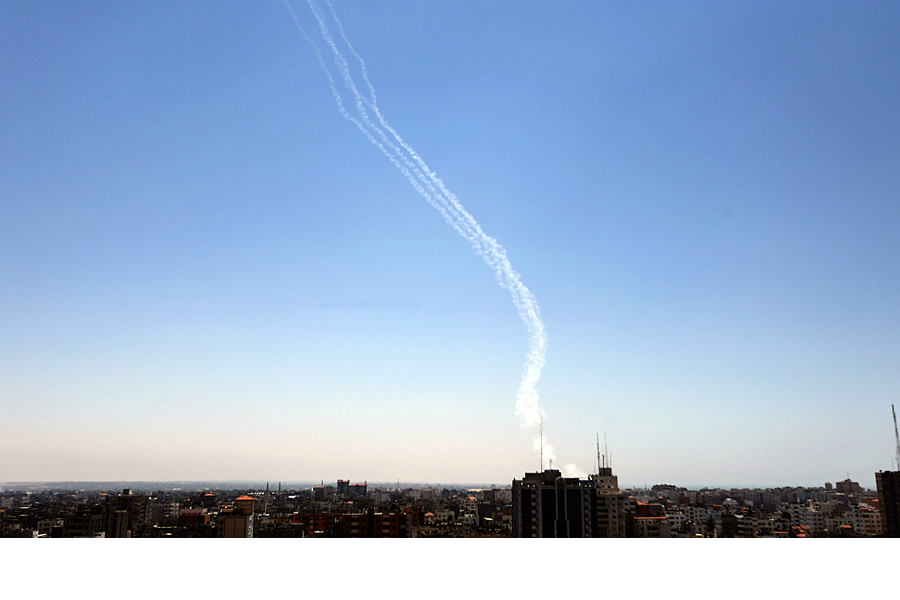Hamas unveils bigger, better rocket arsenal against Israel
| Jerusalem
Hamas has emerged from a 19-month cease-fire stronger, savvier, and more effective at hitting Israel where it will hurt the most.
Hamas's arsenal, estimated at 10,000 rockets, is only marginally bigger than it was heading into its last conflict with Israel, in November 2012. But its mid-range rockets are much more accurate, and it has acquired long-range missiles that reach beyond Tel Aviv and Jerusalem, putting as many as 5 million of Israel’s 8 million citizens at risk.
These new capabilities were revealed last night when a rocket landed in the coastal city of Hadera, nearly 70 miles from the Gaza Strip, almost twice as far away as Tel Aviv. Today Israel detected a rocket targeting an area north of Zichron Yaakov, another 12 miles north.
As Israel launched dozens of air strikes on Gaza, militants from Hamas and other organizations also targeted Tel Aviv, Jerusalem, the country's main international airport, and a number of other cities, setting off rocket sirens across the country. While many were intercepted by Israel's Iron Dome system, two missiles from Gaza landed within the Jerusalem city limits for the first time.
“They have more [rockets and missiles], but more important, the majority of what they have is from the longer-range side,” says former national security adviser Maj. Gen. Yaakov Amidror (res.), who estimates that about 10 percent of the arsenal is now long-range. “They understand where Israel’s weak point is…. Tel Aviv or Jerusalem are much more attractive than Sderot."
A 'highway' for rockets
Sderot, where 24,000 Israelis live within a mile of the Gaza border, was for years the front line for Gaza rocket attacks on Israel. But strategically it was insignificant, and Hamas, with help from Iran, Syria, and Hezbollah, has moved into a different league.
During the presidency of Mohamed Morsi of the Muslim Brotherhood, from which Hamas emerged, Egypt took a more lenient stance on weapons and materiel passing through the hundreds of smuggling tunnels along the Gaza-Egypt border. Since his ouster in July 2013, border security has tightened up.
“Under Morsi it was almost a highway,” says Mr. Amidror, who served as national security adviser from 2011 to November 2013. Rockets as well as supplies and machinery were smuggled in during that window, and Hamas also boosted its production capacity in Gaza, gleaning knowledge from Hezbollah missile experts in Lebanon, he says.
One potential sign of that is the appearance in Gaza of underground rocket launchers, which are connected by tunnels and are harder for Israel to spot and eliminate – at least until the first rocket is launched. The tactic was widely used by Hezbollah during its 2006 war with Israel. Haaretz reports that the IDF targeted 120 underground rocket launchers overnight.
Once Morsi was ousted by the Egyptian military in July 2013, Egypt cracked down hard on the smuggling tunnels, destroying an estimated 90 percent of them. This spring, Israel intercepted the Klos-C ship in the Red Sea, which was carrying an Iranian weapons shipment that included 40 M-302 missiles. Israel claimed the weapons were headed for Gaza.
New hardware
Despite that seizure, Hamas appears to have acquired similar missiles. A spokesperson for the Israel Defense Forces (IDF) says that the missile that hit Hadera last night was an M-302; the name is a reference to the missile's 302-mm caliber. Hamas’s military wing called it an R-160, named after Abdel Aziz al-Rantisi, the Hamas cofounder whom Israel assassinated in a 2004 air strike. Some journalists and analysts have speculated that it may be a homemade version of the M-302, which is normally produced in Syria.
There are five known models of the M-302, which was originally designed in China and has since been manufactured in Syria. Hamas said today that the R-160 has a range of 100 miles (160 km), which matches the D model of the M-302. Only one other M-302 make has a longer range: 124 miles.
The M-302 is “problematic” because it is imprecise, says Uzi Rubin, an Israeli expert on missile defense and the founder and director of a defense ministry program on long-range missiles. However, it is still well-suited for firing at large cities.
Hamas’s M-75s, on the other hand, which were used to target Tel Aviv and Jerusalem last night, have become much more accurate since the 2012 conflict.
“The quality seems to be good, almost factory-like,” says Mr. Rubin, though he notes that the short-range ones are still “kitchen-made.”
Iron Dome buys Israel breathing room
While at least 28 Palestinians have been killed by dozens of Israeli air strikes over the past few days, so far no Israelis have been killed. That’s thanks in part to Iron Dome, Israel's anti-missile system that can intercept rockets headed for civilian areas.
All seven Iron Dome batteries are currently deployed, but it is widely believed that they cannot provide cover for all of Israel and may have difficulty dealing with heavy rocket fire as opposed to individual projectiles.
Still, it gives the government space to determine the best course of military action without the pressure that Israeli casualties would bring, says airborne terrorism expert Hillel Avihai.
“Even though [Hamas has] managed to enlarge the arsenal … Israel has a very good solution,” says Mr. Avihai, a research fellow at the International Policy Institute for Counter-Terrorism in Herzliya. “If we made the calculation of cost-benefit, of course Iron Dome rockets are very expensive compared to Qassam rockets. But if we see it from another perspective, … [it enables] the IDF to go into Gaza or make a strike with the understanding that it has a good defense system."






